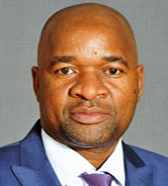21 September 2022
|
Story Dr Olivia Kunguma.
|
Photo Supplied
 Dr Olivia Kunguma, left, and Dr Mmaphaka Tau from DiMTEC.
Dr Olivia Kunguma, left, and Dr Mmaphaka Tau from DiMTEC.
Opinion article by Dr Olivia Kunguma, Disaster Management Training and Education Centre for Africa, University of the Free State, and Dr Mmaphaka Tau, Managing Director: Resilience 4 Development Institute (Pty) Ltd.
On 11 September 2022 a tailings dam wall collapsed at the abandoned Jagersfontein diamond mine in the Free State’s Kopanong Local Municipality, unleashing a thick grey sludge.
The mine is in the Xhariep District Municipality, which is home to about 5 800 people. Following the dam burst, more than 400 people were affected, 51 houses were destroyed, and critical infrastructure was affected.
The dam burst at the mine, which was established in the 1800s and to date has been owned by several mine moguls, led to serious devastation in the community. Within hours of the event the media had already dubbed it the “Jagersfontein disaster”.
But the media cannot loosely report it as a “disaster”. It is not the appropriate classification according to the Disaster Management Act. There is a need for governing institutions and their legislation to be respected and recognised, as this will improve on governance. South Africa has good policies, but implementation is, in certain areas, lacking. Hereunder, we note that there is inappropriate use of terminology, which depicts the inadequate understanding of the disaster risk management function.
What is a disaster?
The DMA defines a “disaster” as a progressive, sudden, widespread, natural, or man-made occurrence that causes or threatens to cause death, disease or injury, damage to the environment, and disruption of life. According to the Act, it is of a magnitude that “exceeds the ability of those affected by the disaster to cope with its effects using only their resources”. At the international level, the United Nations International Strategy for Disaster Reduction (UNISDR) developed a terminology guide that aims to promote a common understanding and usage of disaster management concepts. It assists the authorities and the public (in this case, by “public” we refer mainly to the media) in educating the populace.
For the dam burst to be termed a “disaster”, several steps must be adhered to within South African jurisprudence:
The National Disaster Management Centre (NDMC) must first assess the magnitude and severity of the event, and then classify it as a local, provincial, or national disaster. This assessment also considers the provisions of Section 2 (1)(b) of the DMA, stating that the Act does not apply to an occurrence that can be dealt with in terms of other legislation. The rationale of the above is that the National Disaster Management Framework of 2005 (NDMF) provides that disaster management plans must be developed by relevant organs of states and other entities, who are the custodians of certain hazards or activities to manage disaster risks in their areas of legislative responsibility. For example, mining-related activities are the responsibility of the Department of Mineral Resources and Energy. This department’s mission is clear: to regulate, transform and promote the mineral and energy sectors.
Since the event or incident occurred in a local sphere of government (Kopanong Local Municipality), it can then be classified as a local disaster subject to the satisfaction of the provisions of Section 2(1)(b). According to Section 23(4) of the DMA, an event can be classified as a “local disaster” if it affects a single local metropole, district, or municipality, and that entity can deal with the event effectively. The district municipality and the local municipality are responsible for the coordination and management of the local disaster.
If the event has not been declared as a local state of disaster, other existing legislation, contingency arrangements, or by-laws can guide the management of the event in line with the appropriate contingency arrangements. Other government spheres and state organs can still assist with the management of the event in line with the applicable disaster risk management plans called for under the National Disaster Management Frameworks.

Dr Mmaphaka Tau
Of critical importance and aligned to the thrust of the District Development Model is the provision of Section 54 (4) of the DMA, which asserts that “irrespective of whether a local state of disaster has been declared in terms of section 55, a national or provincial organ of state, or another municipality or municipal organs of state are not precluded from providing assistance to a municipality to deal with a local disaster and its consequences”.
In the same way, and on the strength of section 23 of the DMA, suppose the event has been classified as a local disaster: there are added benefits to dealing with the occurrence, especially in the face of a lack of robust disaster risk management plans and the dearth of disaster risk management implementation capacity both for coordination (by Disaster Management Centres) and mainstreaming (by relevant organs of state and other entities). In that case, the municipal council may declare a local state of disaster by notice in the provincial gazette (See Section 55 of the DMA).
The disaster declaration will then provide for measures such as, but not limited to:
• Available resources such as facilities, vehicles, and funding are released;
• Personnel of the organs of the state are released to render emergency services;
• Evacuation of the affected population to temporary shelters;
• The regulation of movement;
• The dissemination of information;
• The maintenance and/or installation of temporary lines of communication; and
• The suspension of or limiting of alcohol in disaster-stricken areas.
•Therefore, until all the above processes have been followed, the Jagersfontein dam burst can only be termed a “disaster” without the ability to apply the above measures.
Who is responsible, and how can we move forward?
Jagersfontein Developments (Pty) Ltd owns the mine, implying that it should be their primary responsibility, as the asset owner, to actively contribute to the management of the occurrence of an incident. Even the Minister of Mineral Resources and Energy, Gwede Mantashe, rightfully stated that the responsibility of compensating affected individuals would be placed on the mine owners. According to the Mine Health and Safety Act 29 of 1996 and its regulations, “the employer must take reasonable measures to ensure that no person is injured as a result of the failure of any dam wall”. It was reported that the company was warned of the tailings exceeding the authorised waste volumes. But the company did not attend to the warning. It is also assumed that the company is aware of the policies, legislation and standards they should adhere to, such as the Global Industry Standard on Tailings Management (GISTM), which strives to achieve the goals of zero harm to people and the environment, mine safety, and to mitigate catastrophic failure through tailings management. Fortunately, the company has taken full responsibility and has accepted liability. They have also refrained from calling Jagersfontein a ‘mine’, opting to call it a “processing facility”. Perhaps this also has legal implications.
Nonetheless, besides the company taking full responsibility, the government must also play its part and make sure that policies, legislation, standards, etc. are implemented, and that there is full compliance.
They cannot wait for a catastrophic event to occur and then start pointing fingers. This scenario calls for an embracing of the principles and practices of risk-informed development, which calls for an understanding of development that considers multi-faceted, dynamic, interdependent, transboundary, simultaneous, and systemic risks. It thus describes a shift in mindset – across sectors and stakeholders – from managing single hazards to incorporating existing and future risks in all development processes from the outset, and therefore choosing development pathways that prevent the creation of risks. The Jagersfontein case study is a classic case of an ignored Risk Informed Development (RID) approach, which is gravely regrettable.
The limited understanding of the various stakeholders’ roles and responsibilities, and the misinterpretation of important terminology, call for robust capacity development programmes driven by the National Disaster Management Centre in collaboration with Provincial and Municipal Disaster Management Centres. There is also a palpable need for a firm implementation of Priority 1 (Understanding Disaster Risk) of the Sendai Framework for Disaster Risk Reduction 2015-2030 (SFDRR), which states that policies and practices for disaster management should be based on an understanding of risks in all dimensions of vulnerability, capacity, exposure of persons and assets, hazard characteristics, and the environment.